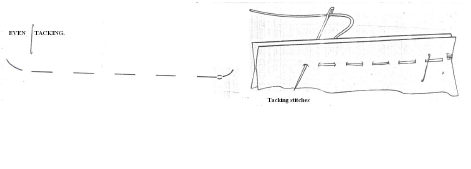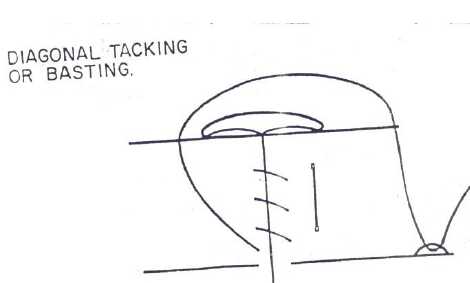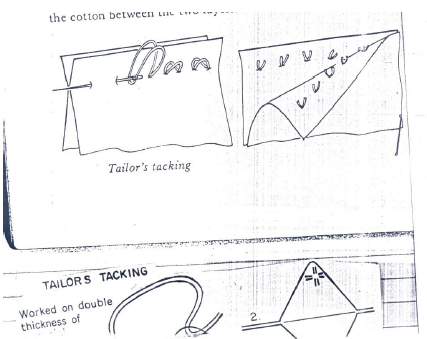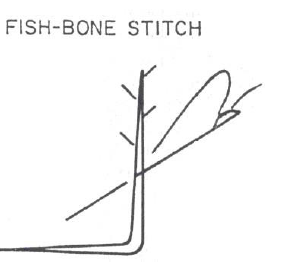These are stitches used to hold fabrics temporarily before permanent stitches are fixed. The stitches re often removed after permanent stitches have been worked on the material being sewn: In view of this soft, cheap white tacking cotton thread is often used for working temporary stitches. Temporary stitches include tacking (even tacking and long and short tacking) diagonal tacking, thread marking, tailor’s tacking, slip basting and fishbone stitch.
1. Tacking
This is also referred to as basting. It is temporary stitch commonly used for holding material also in position. There may be two or more layers of material tacking or bashing is worked with simple thread on either the right or wrong side of material. It is worked from right to left and being temporary stitch, it should be started with double back stitch. There are different types of tacking stitches. They are even tacking, long and short tacking, diagonal tacking, thread-marking and tailor’s tacking. Other include slip basting and fish bone stitch

2. Even Tacking
Even tacking is produced when the length of each stitch is equal on both
front and back of material. There are always equal spaces produced between two stitches. It is the simplest form of tacking. Even tacking is used to hold temporarily seams, hams, facings and others.

3.Long and short Tacking
This is another type of temporary stitch and tacking. It is also known s uneven tacking or irregular tacking in this type of tacking unequal amount of material is passed over as is picked up. The top stitch may be longer than the bottom stitch or vice versa. The long and short tacking otherwise known as uneven tacking is worked on single material for
marking out purposes. Long and short tacking is faster than even tacking. It is very good for holding in position heavier materials before permanent stitch is worked on the material, it helps to hold heavier materials firmly temporarily

3.Diagonal Tacking
This is another form of temporary stitch and tacking stitch. This type of tacking stitch or temporary stitch is very good for joining together temporarily two or more layers of material to avoid them from slipping out of position until permanent stitches are finally fixed diagonal tacking is useful for fixing collars, livings, waist bounds and pleats temporarily.
4.Thread Marking
This is another type of tacking stitch and temporary stitch. It is used for marking out fitting lines, pleat lines and so on. Thread marking is produced with double thread on two or more layers of materials. Series of loops are produced when thread marking is being worked. The layers of materials are gently separated apart through the use of a pair of sharp
scissors for cutting between the threads. After being cut, series of identical and clear lines are formed on the pattern pieces. Thread marking does not require fastening on and off.Tailor’s Tacking These are used to transfer construction marks, e.g. seam notches, darts etc., from a pattern to the cut-out material. These are also temporary
stitches.
Use the cotton double in the needle and have contrasting colour from the fabric. When all the tailor’s tacking has been done, remove the pattern; separate the layers of fabric and cut the cotton between the two layers

5.Fish bone Stitch
Fish bone stitch s used to draw the edges of a clean straight tear along warp and left together before darning this is another form of tacking and it is removed after the darn has been worked with very fine matching thread or a thread drawn from the fabric itself. In some cases it may not be necessary to remove the fishbone stitch so as to help in catching the fabric at the sharp point. Fish bone stitch is mostly used for hedge tear darn.

marto answered the question on
May 2, 2019 at 07:19